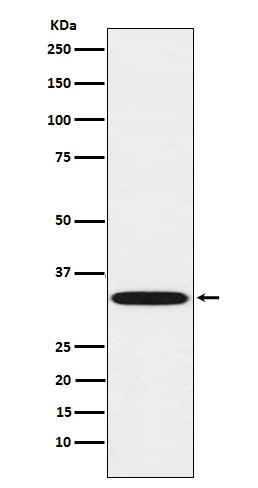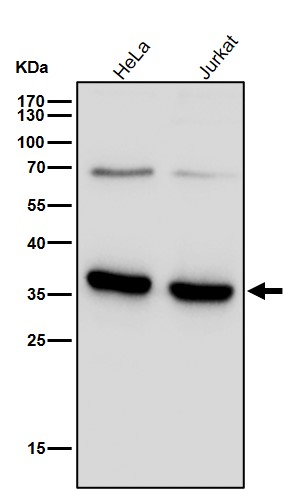


| WB | 咨询技术 | Human,Mouse,Rat |
| IF | 咨询技术 | Human,Mouse,Rat |
| IHC | IHC:1/100-1/200;IHF:1/50-1/200 | Human,Mouse,Rat |
| ICC | 1/50-1/200 | Human,Mouse,Rat |
| FCM | 咨询技术 | Human,Mouse,Rat |
| Elisa | 咨询技术 | Human,Mouse,Rat |
| Aliases | AGS1; AGS5; CRV; DNase III; DRN3; HERNS; TREX1;;TREX1 |
| WB Predicted band size | 33 kDa |
| Host/Isotype | Rabbit IgG |
| Antibody Type | Primary antibody |
| Storage | Store at 4°C short term. Aliquot and store at -20°C long term. Avoid freeze/thaw cycles. |
| Species Reactivity | Human |
| Immunogen | A synthesized peptide derived from human TREX1 |
| Formulation | Purified antibody in PBS with 0.05% sodium azide,0.05% BSA and 50% glycerol. |
+ +
以下是关于TREX1抗体的3篇参考文献及其简要摘要:
1. **Crow, Y.J., et al. (2006).**
**"Mutations in the gene encoding the 3'-5' DNA exonuclease TREX1 cause Aicardi-Goutières syndrome."**
**摘要**:该研究首次发现TREX1基因突变与Aicardi-Goutières综合征(AGS)相关,通过抗体验证突变体蛋白表达缺失,揭示了TREX1在清除自身DNA中的关键作用。
2. **Lee-Kirsch, M.A., et al. (2007).**
**"Mutations in the gene encoding the 3' repair exonuclease TREX1 are associated with systemic lupus erythematosus."**
**摘要**:研究发现TREX1功能缺陷与系统性红斑狼疮(SLE)相关,提出未降解的DNA可能激活免疫系统,促进自身抗体(如抗核抗体)的产生。
3. **Stetson, D.B., et al. (2008).**
**"Trex1 prevents cell-intrinsic initiation of autoimmunity."**
**摘要**:证明TREX1缺陷导致胞内DNA积累并触发I型干扰素反应,研究中利用抗TREX1抗体分析蛋白表达,阐明其在抑制自身免疫中的机制。
4. **Günther, C., et al. (2015).**
**"Defective removal of ribonucleotides from DNA promotes systemic autoimmunity."**
**摘要**:探讨TREX1在清除核糖核苷酸中的作用,发现其功能缺陷通过cGAS-STING通路激活免疫,可能使用抗体检测TREX1相关分子互作。
**说明**:上述文献主要涉及TREX1的功能及其与自身免疫疾病的关系,部分研究通过抗体验证蛋白表达或机制(如Crow和Stetson的研究)。目前关于TREX1自身抗体的直接研究较少,更多聚焦于基因突变或功能异常导致的免疫失调。
TREX1 (Three Prime Repair Exonuclease 1) is a DNA exonuclease critical for maintaining genomic stability by degrading excess cytosolic DNA, thereby preventing aberrant immune activation. Mutations in the *TREX1* gene are linked to autoimmune and inflammatory disorders, including Aicardi-Goutières syndrome (AGS), systemic lupus erythematosus (SLE), and familial chilblain lupus. TREX1 antibodies are immunological tools used to detect and study the expression, localization, and function of the TREX1 protein in research settings. These antibodies are essential for investigating TREX1's role in DNA damage repair, antiviral responses, and autoimmune pathogenesis.
In research, TREX1 antibodies are employed in techniques like Western blotting, immunohistochemistry, and immunofluorescence to analyze protein levels in cellular or tissue samples. They help elucidate how TREX1 dysfunction contributes to disease mechanisms, such as the accumulation of self-DNA triggering type I interferon pathways. Commercial TREX1 antibodies are often validated for specificity across human, mouse, and other model organisms due to TREX1's conserved structure. Studies using these antibodies have advanced understanding of TREX1's interactions with nucleic acid sensors (e.g., cGAS-STING) and its potential as a therapeutic target. However, variability in antibody quality and cross-reactivity remains a challenge, emphasizing the need for rigorous validation in experimental contexts.
×